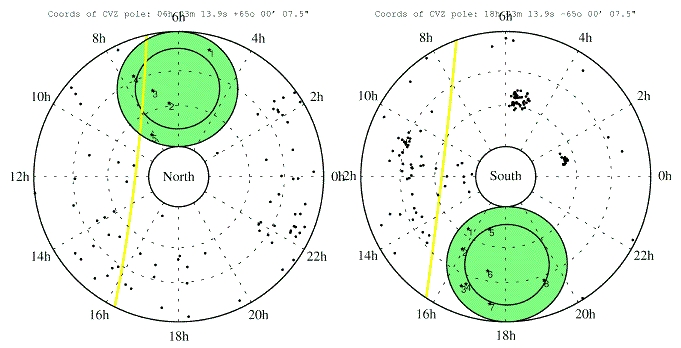

Mission Status Report #18 Star Date: September 16, 1999 NOTE: Mission Status Reports on the web page will continue roughly once a week, as events unfold. 
Graphic showing the two FUSE Continuous Viewing Zones projected onto the sky. Calculation was for 00:00 UT on Sept. 16, 1999. The area to the left of the yellow lines is unavailable due to spacecraft constraints.
FUSE Leaves the CVZ!The In-Orbit Checkout phase of the FUSE mission continues, with slow but steady progress toward a fully functional satellite. The memory fragmentation problem discussed in the last report was indeed cleared up by a reboot procedure, and we are running smoothly on that front again. Also, slews and acquisitions of target fields have been going much more smoothly, although problems with the FES guide cameras have continued sporadically and have affected several tests we tried this week. The good news here is that a software patch to fix these problems was delivered by ComDev and uplinked last night! Initial tests look good, but only time and testing will confirm whether we have successfully wrestled this problem to the ground. A significant event occurred this week: we have performed a number of slew maneuvers that moved our look direction away from the Continuous Viewing Zone (or CVZ; the regions roughly perpendicular to the orbit plane where we can view the sky constantly). In these new orientations, the earth periodically blocks the telescope's view of a target field. Then when the view is clear, the telescope reacquires guide stars and proceeds with scheduled activities. All of these activities are calculated ahead of time and uplinked to FUSE in a process we call "mission planning". Since this is the way the vast majority of FUSE observations will be scheduled, it was a significant step to demonstrate this capability. During the last week, we actually slewed from the southern CVZ to the northern CVZ, stopping at several places along the way, and then reversed the procedure and came back down to the south. The reacquisition of targets has been demonstrated a number of times now, and confidence is building in our ability to acquire objects properly. Interestingly, we have spent so much time pointing in the CVZ for two reasons: 1) safety concerns, and 2) convenience! The safety concerns were primarily for early in the mission, about the first two months. Any satellite "outgasses," or releases trapped gasses from its structure, for awhile after it is in orbit. The concern for FUSE was that pointing toward the sunlit side of the earth (and hence "seeing" reflected light from the earth with the telescopes) might cause chemical reactions with the stuff being outgassed. If this material collected on the mirrors or other optics, it could quickly degrade our sensitivity to the far-UV wavelengths of light we need to observe! Hence, we were very careful to stay pointed away from the earth until now. Outgassing should essentially be complete at this point. The convenience part has to do with the fact that we can't talk to FUSE at any old time, but only 7-8 times a day (for 10-15 minutes at a time) when it is within range of our ground station in Puerto Rico (or sometimes a staion in Hawaii). Since so much of the checkout so far has been accomplished during real-time contacts with the ground, it was a real convenience to be able to have FUSE in a position to "see stars" at those times. Now that we have some confidence in our operations, we can begin scheduling things to happen when we are out of direct contact, and actually have a reasonable expectation that they will happen on schedule! To the extent that things don't always work right, you can perhaps understand why checkout seems to proceed slowly at times. If, when you come back into contact, there was a problem of some kind, not only does it disrupt the planned flow of activity, but one has to spend a considerable fraction of those precious ground station contacts analyzing and fixing the problem. In any event, one of these weeks very soon I hope to be able to report substantial progress toward focus and alignment of all four telescopes! Then we will be in business for doing some science! Reported by: Bill Blair, Chief of Mission Planning P.S. Last September our ground station in Puerto Rico was ravaged by hurricane Georges. Today, as I file this report, hurricane Floyd (or what's left of it!) is pounding Baltimore! So far, the control center and operations here have been unaffected.
|